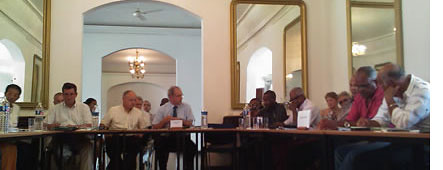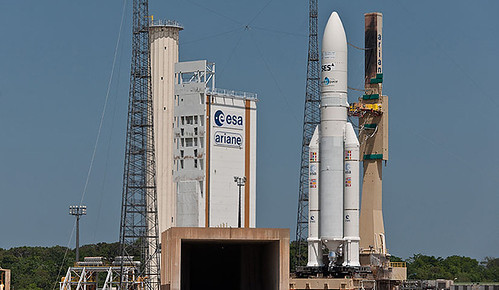
The scale of the disaster in Japan, who some have compared to “four Katrinas,” is as mind-boggling today as it was a week ago. The automatic reaction in the satcom community was one of “ready, set, go” — let’s get our satcom systems turned up to help with communications efforts. The ITU cobbled together a bunch of satellite phones and terminals, et. al. as quickly as it could…
Among material already deployed are 78 Thuraya satellite phones equipped with Global Positioning System (GPS) technology to facilitate search and rescue efforts, along with 13 Iridium satellite phones and 37 Inmarsat Broadband Global Area Network terminals. An additional 30 Inmarsat terminals are ready for dispatch. The equipment can be charged by car batteries and are supplied with solar panels to enable operations during power outages.
This may seem as if it’s not nearly enough to help, but you should also consider the response inside Japan. Only yesterday did the Ofunato City Hall get a much-needed satcom connection via the KIKU No. 8 (ETS-VIII) mobile satellite system…
On March 24, JAXA set up a ground antenna and the movable test communication terminal for the KIKU No. 8 at the Ofunato City Hall to connect the communication line of up to 768 Kbps between the City Hall and the Tsukuba Space Center via KIKU No. 8 in cooperation with the National Institution of Information and Communications Technology (NICT) based on a request from the Ministry of Education, Culture, Sports, Science and Technology, which received a petition from Ofunato City, Iwate Prefecture.
No. 8 at the Ofunato City Hall to connect the communication line of up to 768 Kbps between the City Hall and the Tsukuba Space Center via KIKU No. 8 in cooperation with the National Institution of Information and Communications Technology (NICT) based on a request from the Ministry of Education, Culture, Sports, Science and Technology, which received a petition from Ofunato City, Iwate Prefecture.
With this communication line installation, Ofunato City Hall workers began collecting information by PCs through the Internet. Apart from city hall, local fire departments and other offices can also now use the Internet and IP telephones to share information for strengthening their cooperative activities.
In addition, as one of the special features of the KIKU No. 8 is communications with a small movable test terminal, which was installed at Ofunato City, information dispatch from evacuation centers and other places through the Internet became possible, because it is easy to move around and install it. Therefore, the connection this time is expected to further contribute to a smooth recovery from the disaster.

Simply getting these terminals out to where they were needed took time — and to find power sources. Most can be powered by a car battery, but they weren’t easy to find. Having a handheld unit is wonderful, until you need to recharge. As many found during last winter’s storm and subsequent power outages in the U.S., you could maintain your Internet connection/communication with an iPhone — only you’d be charging it in your car. In Japan, you car may have been washed away or buried under tons of debris, miles away. So that’s not an option.

Nobody could have predicted this type of utter destruction of property and the communications and power-transmission systems failures. The challenge of preparing satcom systems to respond effectively is to make sure there’s capacity available to meet the demand. As with the REDiSat Network, developed by SES Americom in response to Hurricane Katrina in 2006, nobody wants to pay for capacity that’s not needed. Full-time customers are ready to today, so they fill up the spectrum for their businesses. You can’t simply bump them to make room for emergencies when they have hundreds of customers depending on it for their livelihood.
That’s when the government needs to step in and help foot the bill. Help the satcom operators keep satcom inventory ready to deploy in case of emergency, only not at the target 80% EBITDA margins. A reluctance to part with capacity at a lower profit margin caused the REDiSat Network to fade away. Designing, building, testing, launching and operating a satcom spacecraft is expensive and they do serve the public well.
Broadcasters’ reliance on — and willingness to pay for — satcom systems is a wonderful arrangement. It’s magic: an infinite number of receivers for video and a good source of cash flow for the satellite operators. Keeps a lot of rocket scientists employed, too. As good corporate citizens, shouldn’t some of the profits be set aside to provide satcom capacity when needed?
I’m sure the accountants can find a way to pay for it.
Anybody who has capacity available in the region is likely booking it for TV news. Only SKY Perfect JSAT has any meaningful response (opens in PDF) …
As a measure for supporting post-disaster recovery, we are allocating necessary transponders capacity to anti-disaster organs, etc. and preparing for aid measure one by one. At present, the number of applications for subscription is increasing steeply. We are dealing with it as follows: For recovery assistance, we will immediately conduct what we can do with our communication satellite. We hope that the devasted area will be restored soon.
About the use of satellite communication services
- We will first distribute transponders to the institutions for post-disaster recovery, such as National Police Agency, the Ministry of Defense, related ministries, Telecommunication carriers and the U.S. military.
- As for the use of bands by electric power companies, including TohokuElectric Power, we will assist them proactively and give priority to them to allocate the cacant bands of Superbird-B2 owned by SKY Perfect JSAT
- As for the steep increase in the use by media organizations, we will deal with it thoroughly, and as for new subscriptions, we will allocate the band of JCSAT-5A, which has some room.
Where are the “we’re helping” press releases from the major satcom players?











 No. 8 at the Ofunato City Hall to connect the communication line of up to 768 Kbps between the City Hall and the Tsukuba Space Center via KIKU No. 8 in cooperation with the National Institution of Information and Communications Technology (NICT) based on a request from the Ministry of Education, Culture, Sports, Science and Technology, which received a petition from Ofunato City, Iwate Prefecture.
No. 8 at the Ofunato City Hall to connect the communication line of up to 768 Kbps between the City Hall and the Tsukuba Space Center via KIKU No. 8 in cooperation with the National Institution of Information and Communications Technology (NICT) based on a request from the Ministry of Education, Culture, Sports, Science and Technology, which received a petition from Ofunato City, Iwate Prefecture.
